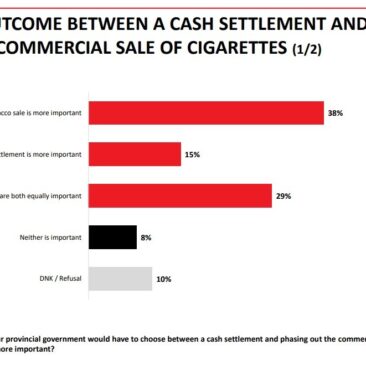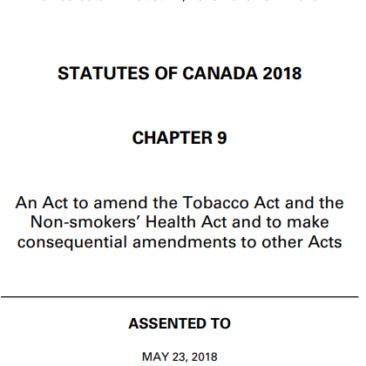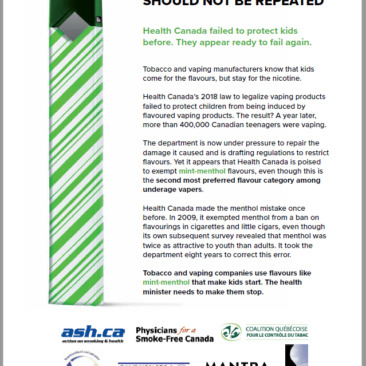More public opinion research results have recently appeared on the Library of Canada web-site. Among them are the results of two series of focus groups conducted as part of the overhaul of health warning messages (HWM) that are printed on the outside of tobacco product packages and Health Information Messages (HIM) that are printed on the inside.
This post reports on report Number POR-025-19 Qualitative Testing of New Health Information Messages, Including Placement Options, as well as the Thematic Linking of Labelling Elements – 2019.
15 in-person focus group tests were conducted with 132 regular smokers spread over Toronto, Wiknnipeg, Edmonton, St. John’s and Quebec City. Five focus groups each were held with youth (ages 15-19), young adults (ages 20-24) and adults (aged 25+). The sessions were held mid-summer (July 13 and 27).
Time to move the messages?
The researchers found that the current HIM’s, which are printed on the back of slide and shell packages or are included as inserts in flip-top packs, are not getting noticed. “Very few participants said they pay attention to the HIMs when they purchase a new package of cigarettes.”
In reponse to this concern, Health Canada has proposed alternative locations for the messages. All of these are based on moving to a standardized slide-and-shell package format, as will be required next year when the plain and standardized package regulations come fully into force.
Of the formats tested, the most noticeable (and “annoying”) of these was an extension of the top flap that went over the top of the cigarettes. Other options included a sticker covering the foil of the cigarettes and an extension of the interior tab. Illustrations of these three formats are shown at the end of this post, as are the messages tested.
Time to change the messages?
Eight new health information messages were tested. Two presented specific benefits of stopping smoking (lowering the risk of diabetes and improving skin health). Three were new presentations of quit tips and suggestions.Three encouraged smokers to think about switching completely to vaping products.
Each smoker was asked to rank the messages in terms of how effective they were at providing information about the benefits of quitting and how effective at making them think about quitting.
Generally speaking, the researchers found “participants were more likely to react positively to concepts that conveyed a meaningful benefit of quitting over ones that focused mostly or entirely on tips to help them quit.”
The proposed messages to encourage smokers to switch completely to vaping, however, were firmly rejected by the smokers. As the researchers describe it:
“Reactions to HIMs on Vaping
Three HIMs suggested that switching completely to vaping can reduce exposure to harmful chemicals in cigarette smoke and could be a potential method to quit smoking cigarettes. A good number of participants could relate to using vaping as a strategy to quit smoking cigarettes entirely. However, many felt that these HIMs either did not have enough information about vaping or that they have heard too many bad things about vaping (e.g. the chemicals it contains, exploding devices, popcorn or bubble lung, etc.) for it to be considered a viable alternative to smoking cigarettes. While most could appreciate that vaping may be different from smoking cigarettes, most also felt it was like replacing one addiction or “evil” for another. In the end, most would agree that the “jury is still out” and that the long-term effects of vaping have yet to be understood.As such, very few felt comfortable with the idea of replacing cigarette smoking with vaping and most were also quite uncomfortable, even upset, with what they perceived as Health Canada recommending, endorsing, or promoting vaping. In the end, only a few felt that it was a strategy worth suggesting, especially coming from Health Canada.…One of the biggest reactions came from the discussion around vaping. Three HIMs (#17, #24 and #25) suggested that switching completely to vaping can reduce exposure to harmful chemicals in cigarette smoke and could be a potential method to quit smoking cigarettes. Vaping elicited mixed reactions when participants read these parts of the HIMs. While a good number of participants could relate to using vaping as a strategy to quit smoking cigarettes, most were reluctant to accept the idea of positioning vaping as an alternative to smoking in the HIMs. This reluctance was in large part driven by concerns that the long-term health effects of vaping are unknown. Many also mentioned that they had come across too many conflicting reports about the benefits and harmful effects of the product. Many felt they did not have enough information about vaping and that they have heard too many bad things about vaping (e.g. the chemicals it contains, exploding devices, popcorn or bubble lung, etc.) for it to be considered a viable alternative to smoking cigarettes. As far as participants could tell, they felt that switching from smoking cigarettes to vaping was switching from one addiction or bad habit to another.
Participants were especially concerned about seeing vaping messages on HIMs put out by Health Canada. They felt that Health Canada was “endorsing” or “promoting” vaping and this left them feeling uneasy and, in some cases, upset. For many, this left them questioning the credibility of Health Canada. For a few participants having seen other Health Canada messaging describing the ill effects of vaping, seeing these HIMs left them wondering if Health Canada was “talking out of both sides of its mouth.”
Conversely, not all reactions about vaping were negative. There were a few participants in each city who didn’t mind seeing vaping as an alternative to smoking in the HIMs. Some participants felt it was good to see Health Canada suggest an alternative to smoking cigarettes directly in a HIM, rather than just recommending to quit cold turkey. A few participants had done a lot of research about vaping and agreed with the HIMs that vaping would be better than smoking cigarettes. A few also emphasized that vaping was much more affordable than smoking cigarettes, and that as a benefit to quitting smoking cigarettes, the financial angle could be discussed in the HIMs in addition to the health-related ones.
In general, participants wanted to see more public education about vaping before they would consider switching to vaping. They wanted specific statistics rather than general statements.
Some common questions were:
* How is it better than cigarettes?
* What are the chemicals in vape liquids?
* What are the long-term effects of vaping?
* What is the success rate among those switching completely from smoking cigarettes to vaping?



















